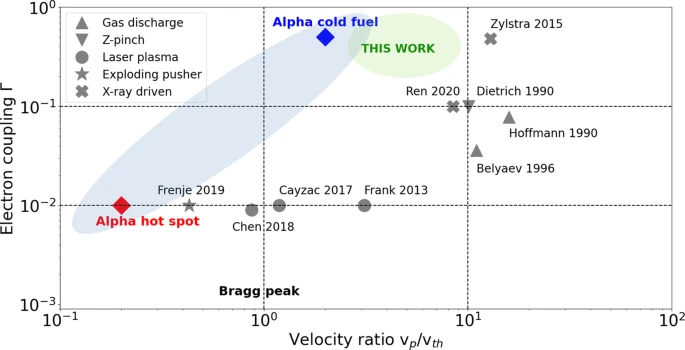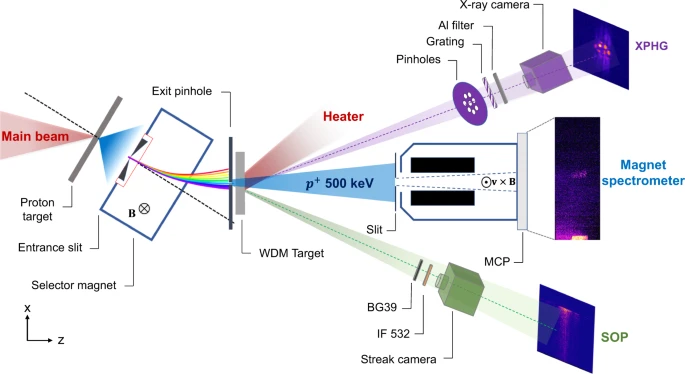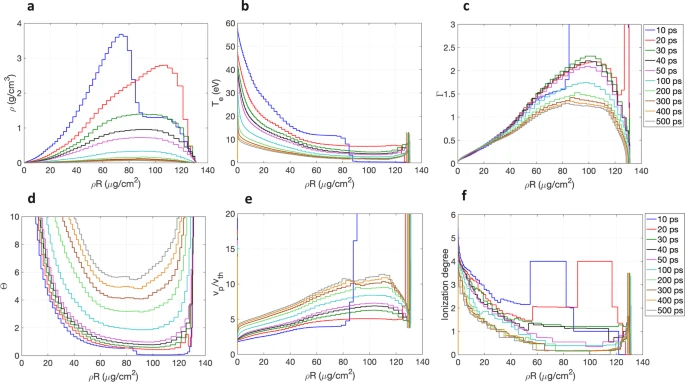 By Surbhi JainReviewed by Susha Cheriyedath, M.Sc.May 26 2022
By Surbhi JainReviewed by Susha Cheriyedath, M.Sc.May 26 2022In an article recently published in the open-access journal Nature Communications, researchers discussed the low-velocity proton stopping experiments in warm dense carbon.

Study: Proton stopping measurements at low velocity in warm dense carbon. Image Credit: TR STOK/Shutterstock.com
Background
In inertial confinement fusion (ICF) methods, ion halting in warm dense matter (WDM) is an important problem. Understanding proton transport in the matter and studies using ion beams to generate dense plasma states, such as proton isochoric heating, require a thorough understanding of ion stopping in WDM. These experiments can be used to investigate the equation-of-state, structure, and transport properties of dense plasmas, as well as the thermal equilibration and conductivity of WDM materials.
The majority of ion-stopping studies have been carried out in traditional, highly ionized plasmas under ideal and nondegenerate conditions. Due to electron coupling and degeneracy, theoretical modeling for WDM target circumstances is more complex, requiring more advanced theories such as quantum many-body methods and first-principles calculations.
Thin samples with significant hydrodynamic expansion within tens to hundreds of picoseconds are required for such low probing energy. As a result, precise stopping measurements necessitate a probing beam duration equal to or less than the sample lifespan. Short pulse lengths and a broad energy spectrum of laser-generated proton beams provide the essential flexibility to overcome these restrictions. As a result, they've been employed in a number of recent halting studies in conjunction with an energy filtering device to choose a limited energy band.

Selection of reported ion-stopping experiments. Experiments displayed in the parameter space of the velocity ratio vp/vth of the beam-plasma interaction and the target electron coupling Γ. The grey symbols mark the plasma generation method used. The shaded blue zone represents the approximate range of vp/vth and Γ values corresponding to the α-particle emission in an igniting ICF experiment, ranging from the cold fuel to the hot spot conditions. The experiment described in this work, indicated by the shaded green zone, lies in an unexplored parameter range that is relevant for α-particle stopping conditions in the cold fuel. Image Credit: Malko, S et al., Nature Communications
About the Study
In this study, the authors presented proton energy loss measurements in warm dense plasma at unprecedented low projectile velocities. The obtained energy-loss data, together with a precise target characterization based on plasma-emission observations employing two independent spectroscopy diagnostics, was used to show that the stopping power in this range deviated significantly from classical models.
The team used an experimental approach that was based on a laser-generated proton selection platform which was operated at a high repetition rate at a short-pulse laser facility. The proposed energy-loss data, along with a complete assessment of the WDM circumstances using two complementary spectroscopy diagnostics, provided the first test of ion-stopping models in this previously unknown region. The first 200 TW VEGA2 laser beam was split into two brief pulses, known as the main and heater beams, respectively.
The researchers devised a setup that consisted of four main stages. The first was for the generation of the proton beam using the main laser beam. The second corresponded to the generation of the WDM sample using the heater beam. The third was associated with the measurement of the downshifted spectrum of the proton beam that passed through the WDM target using a magnet-based spectrometer. Finally, the fourth one was dedicated to the characterization of the WDM conditions using two independent spectroscopy diagnostics.

Experimental setup. Scheme of the experimental setup for each shot: (i) selection of a 500 keV energy proton beam from an initial broadband TNSA spectrum generated by the main beam, (ii) WDM sample generation by the heater beam, (iii) measurement of the downshifted proton energy spectrum of the selected beam after passing through the WDM target and (iv) characterization of the WDM sample by the SOP and the XPHG diagnostics. Typical raw experimental data acquired for each shot are shown for the magnet spectrometer as well as for the SOP and the XPHG diagnostics. Image Credit: Malko, S et al., Nature Communications
Observations
The plasma emission measurements, which were performed simultaneously with the stopping measurements using the streaked optical pyrometry (SOP) and XUV pinhole grating (XPHG) spectroscopy diagnostics, provided a WDM target characterization that was never accomplished in previous stopping studies. The experimentally determined temperature agreed with hydrodynamic predictions within 20%. This verified sample probing in the intriguing regimes of degeneracy (Θ ≤ 4) and intermediate coupling (Γ ~ 1-2). It was also shown that the obtained results were the most consistent with recent first-principles simulations using time-dependent density functional theory.
Proton energy loss was observed in a warm dense carbon target heated by a second short-pulse laser using the proposed apparatus in a low-velocity regime. The projectile energy of roughly 500 keV resulted in vp/vth ratios of three to 10, which were much lower than in earlier tests. Discrepancies between first-principles stopping-power calculations and classical predictions could approach 20% under these conditions and could be resolved empirically.
The proposed system could handle a wide variety of proton energies from 100 keV to two MeV, as well as proton pulse duration, temperature, and density. When the proton energy was lowered to 100 keV, and the target temperature was kept at 10 eV, a velocity ratio, vp/vth = two was obtained.

RALEF2D hydrodynamic simulation. Target profiles along the plasma central axis for t = 0–500 ps after the beginning of the laser heating. a Mass-density. b Electron temperature. c Electron coupling Γ. d Electron degeneracy Θ. e Velocity ratio vp/vth for 500 keV energy projectiles. f Mean ionization calculated with the FLYCHK code at LTE. Discontinuities at early time are a calculation artefact. The x-axis is reported in areal-density units (μg/cm2). Sharp edges located at the target rear face (areal density ≈ 130 μg/cm2) are an isolated numerical simulation artefact. Image Credit: Malko, S et al., Nature Communications
Conclusions
In conclusion, this study presented the proton energy-loss observations in warm dense carbon at 500 keV energy, with a velocity ratio of vp/vth ≥ three. When the obtained experimental results were compared to the known stopping-power models, it was found that the density functional theory estimates have the best match. This emphasized the effect of electron coupling and degeneracy in WDM at low projectile energy, which reduced stopping power when compared to traditional techniques.
The authors mentioned that this finding has important consequences for investigations in which the energy loss of ions in WDM is important and where stopping-power modeling is typically used. They believe that as a result, more comprehensive calculations based on first-principle approaches like the Density Functional Theory are required in this halting regime.
Disclaimer: The views expressed here are those of the author expressed in their private capacity and do not necessarily represent the views of AZoM.com Limited T/A AZoNetwork the owner and operator of this website. This disclaimer forms part of the Terms and conditions of use of this website.
Source:
Malko, S., Cayzac, W., Ospina-Bohórquez, V., et al. Proton stopping measurements at low velocity in warm dense carbon. Nature Communications 13, 2893 (2022). https://doi.org/10.1038/s41467-022-30472-8. https://www.nature.com/articles/s41467-022-30472-8